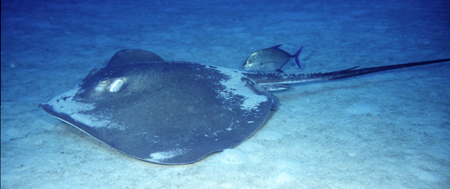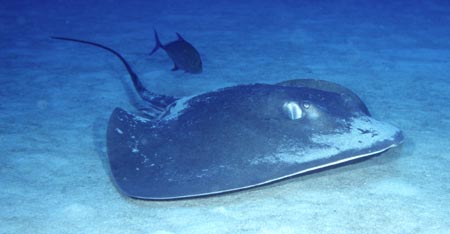|
BROAD STINGRAY
(Brown Stingray)
Dasyatis lata (Garman, 1880)
This is Hawaii's most common
stingray. Its roughly diamond-shaped body has convex borders and
is slightly wider than it is long. When viewed from above, its front
tip is distinctly pointed. The tail is twice the length of the body
and a fold or keel of skin runs along its underside. The wide portion
of the tail is studded with spiny tubercles. As in all stingrays,
a venomous spine sits atop the tail just behind the body. The species
is said to attain at least 5 ft. in width, although 3 ft. is more
usual. It is known only from Hawai`i and Taiwan.
Finding a stingray is unusual in Hawai`i. These bottom-dwellers
are most common in muddy or silty embayments such as Maui's Ma`alaea
Bay and O`ahu's Kane`ohe Bay, where divers and snorkelers seldom
go. They will also live over sand, however, and divers occasionally
encounter them foraging adjacent to reefs or lying half-buried.
Depths are typically about 50 ft. or more, although I once saw one
in 8 ft.
Although you may never see a stingray,
you can tell if you're in stingray country by the presence large
craters and pits in the sand, created by rays as they excavate for
buried prey--perhaps sand-dwelling fish, worms, crustaceans, molluscs,
or echinoderms. To see a large active ray churning up great clouds
of sand must be quite a sight. A jack often follows a foraging ray,
possibly to nab small escaping animals or perhaps just to get scraps.
Tracking stingrays
Little
is known about the biology or ecology of stingrays in Hawai`i--or
anywhere for that matter. Researchers in Kane`ohe Bay, O`ahu, recently
caught a number of Broad Stingrays with hook and line, tagged them
with acoustic transmitters, and let them go. By following individual
rays with small boats for periods of up to 74 hours, they discovered
that the rays range widely at night, are less active by day, and
do not return to predictable areas to rest. It would seem from this
that the rays forage mostly at night. If this is so, it might also
follow that prey animals are more abundant near reefs because 30
percent of the positional fixes were within 60 ft. of the edge of
a reef. Known available prey from the muddy bottom of Kane`ohe Bay
consists primarily of small burrowing polychaete worms, gobies,
shrimps, crabs, and possibly reef fish that bury themselves at night.
The photos on this page were all taken
at Pupukea, O`ahu, at a depth of 70 ft. at a specific location where
I have seen rays off and on for over 10 years. The pictured ray
was about 3 ft. wide. The jack is a small Bluefin Trevally (Caranx
melampygus). In recent years large stingrays have become popular
exhibit animals in Island aquariums and resorts. The scientific
species name is Latin for "broad."
|
Other
Hawaiian stingray species
In addition to the species above, the Diamond
Stingray (Dasyatis dipterura) has also been recorded from Hawaiian
nearshore waters. (The scientific name is listed as D.
hawaiiensis or D. brevis in older books and the common
name Hawaiian Stingray is also used.) This species, normally a resident
of the Eastern Pacific, is rarely seen in Hawai`i.
How to tell the two apart? The Diamond
Stingray is about the same size and color as the Broad Stingray but
it has two folds or keels of skin running down its tail, one on the
upper and one on the lower side. (The Broad Stingray has a single
fold on the underside.) In addition, the Diamond Stingray's tail is
only about 1.5 times the length of the disc, whereas the Broad Stingray's
tail is about twice the length of the disc. If you see a Diamond Stingray,
I'd like to hear the details. Try to confirm the ID with a photo of
the tail.
The Violet Stingray (Dasyatis violacea),
a pelagic species which lives in the open ocean far from land, is
present offshore in Hawaiian waters. |


